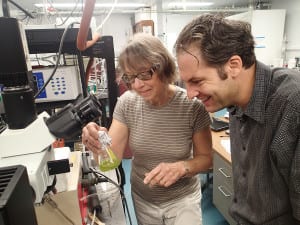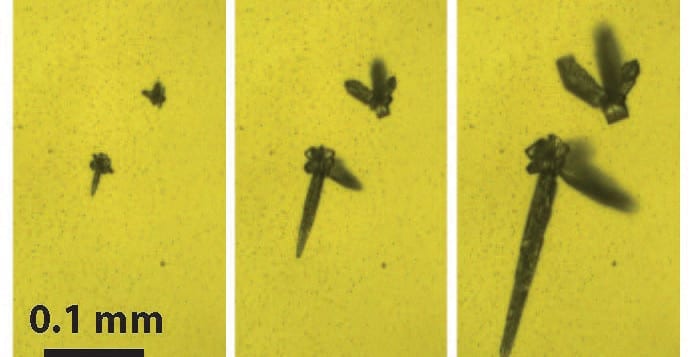Bursting bubbles send plankton parts skyward, Stony Brook team finds
Look, up in the sky! It’s a bird, it’s a plane, it’s … phytoplankton? Parts of tiny creatures that live on the top layer of the oceans, and the stuff they excrete, get carried into the air when bubbles at the surface burst and waves break on top of them. These airborne particles help form ice clouds.
In large parts of the Southern Ocean, the North Atlantic and the North Pacific, sea spray aerosol containing this marine biogenic material can represent a source of ice-forming particles.
While researchers had known that parts of these microorganisms could become freed from their water environment and rise into the air, they didn’t realize the extent to which so-called exudate material, which is secreted or released by phytoplankton into the water, could also become a part of ice clouds. This includes excess material from phytoplankton photosynthesis, waste material and other secretions.
“We found the ice forming material in the ocean microlayer and can attribute it to material produced by photoplankton,” said Daniel Knopf, an associate professor at the Institute for Terrestrial and Planetary Atmospheres at Stony Brook’s School of Marine and Atmospheric Sciences.
Indeed, Lynn Russell, a professor of Climate, Atmospheric Science and Physical Oceanography at Scripps Institution of Oceanography, described these results, which were recently published in the journal Nature, as a “big step.”

“It’s an interesting finding,” Russell said. “This shows that [other] organic material” can contribute to the formation of ice clouds.
Josephine Aller, a professor at the School of Marine and Atmospheric Sciences, said understanding the role of phytoplankton in the atmosphere could offer a better awareness of how any changes that affect phytoplankton, such as an increase in carbon dioxide or a rise in temperature, might also change the formation of clouds.
The Stony Brook researchers combined field work, which included a northwest Atlantic cruise, and lab work performed at Stony Brook and at the Advanced Light Source at Lawrence Berkeley National Laboratory. The Stony Brook team probed microlayer film to determine its spectroscopic, or chemical, signature. They discovered the controlled experiments produced particles that were similar to the ones in the field.
Finding the same material in the lab that they observed in nature was “like a rocket launch,” said Knopf. “For me, I thought, ‘Wow, this half millimeter thick ocean surface may affect a cloud at ten kilometers in height.’ How incredible is that?”
Over oceans, where dust and inorganic materials are scarce, ice clouds can form around these phytoplankton parts.
Some studies over the last few years suggest that ocean acidification is likely to impact biological processes in ocean surface waters and modify the nature and production of organic matter, Aller said. If this happens, there may be an effect on material that is transferred from the surface to the atmosphere, with the greatest effect likely occurring in polar regions.
Scientists don’t yet have enough of the big picture, such as a vertical distribution and numbers of particles and a physical description of how ice forms depending on temperature and relative humidity, to feed this information into global climate models, Knopf said.
To gather more information about clouds and the particles that make them up, researchers have used converted spy planes that take 20 minutes to reach their target altitude and can collect data for about seven hours.
“The pilot has to be like an astronaut in a space suit,” Knopf said. “Our knowledge is a bit limited” due to the limited sampling opportunities.
While scientists know that thunderstorm clouds have a cooling effect, while others, such as cirrus clouds, have a warming effect, they can’t always predict the type of clouds that will form under different conditions. The specific cloud type depends on the particle involved, Knopf said.
Still, the two scientists, who have worked together for seven years, said they will continue collecting this kind of information which, one day, may offer a greater understanding of how a changing ocean might impact phytoplankton growth and potentially the release of airborne particles.
A resident of Huntington, who is originally from Germany, Knopf and his wife, Jeong-A Seong, have a primary school daughter. Aller, meanwhile, lives in Stony Brook with her husband, Robert Aller, a distinguished professor at the School of Marine and Atmospheric Sciences. The couple have four adult children.
As a trained physicist, Knopf said he appreciates how his awareness of phytoplankton’s role in the atmosphere can inform what he sees.
“I go to the beaches on Long Island and I see the film and I sometimes think, ‘maybe this thing, in two weeks, is … making ice crystals,’” Knopf said. Under the right conditions “it could come back as a raindrop.”







